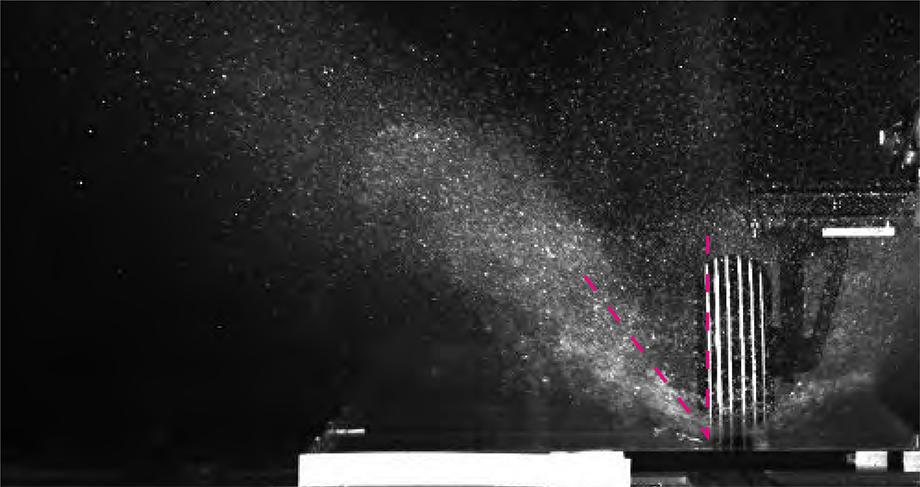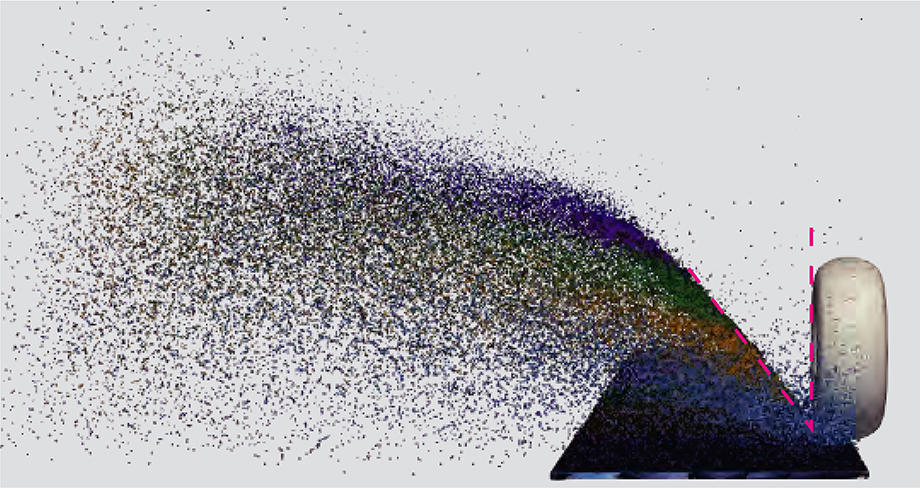Aeronautical Technology Directorate
A Collaboration Between Experimental and Numerical Study Units
Predicting "Water Spray" Generated
by Aircraft Tires
Flooded runways cause water spray around the aircraft body. This raises the risk for aircraft landing and takeoff operations, such as requiring longer distance due to water resistance or, depending on the angle and volume of the water spray, causing engine flameout resulted from water ingestion. In most airports in Japan, grooves, or thin channels, are cut into runways. Designed to drain water, these grooves help prevent large water puddles and generally keep the risk at bay. However, evaluations on the effect of water spray generated by aircraft tires are crucial for the development of aircraft as aircraft fly across the globe. To address this need, JAXA's Aeronautical Technology Directorate is currently undertaking research and development of technologies for predicting water spray generated by aircraft tires.
Water spray measurement using running test apparatus

Numerical simulation by P-Flow

A comparison between a running test in the experimental setup and P-Flow simulation. The images show the angle of water spraying from the side of an aircraft tire to be generally consistent (dotted red lines). Additional studies will be conducted to examine the impact of tire deformation and other factors to further improve prediction accuracy.
What distinguishes this R&D project is its collaborative nature: The Aerodynamics Research Unit performs water spray testing and measurement by constructing experimental setups from the scratch, while the Numerical Simulation Research Unit develops P-Flow, a numerical code using a moving particle simulation method. The Aerodynamics Research Unit measures the distribution of water spray in a variety of conditions and accumulates data, while the Numerical Simulation Research Unit compares the measurement data against simulation data and studies the differences. Based on the results, adjustments are made to the models to enhance the accuracy of numerical results. KOGA Seigo, Researcher at the Aerodynamics Research Unit, comments on this research project launched in April 2018: "Since the project addressed a new theme, we began by thinking about what experiments and setups would be applicable. We asked the Numerical Simulation Research Unit to join us for discussions at this stage, so that we both could share the same vision of experimental and analytical conditions."
The experimental efforts to measure water spray began in FY2018 with a simplified setup using a water tank one meter long. In FY2019, water spray measurement test was conducted in a quasi-full-scale experimental setup that uses a dolly moving along a 50-m rail and tires for small aircraft run on it. For the running test scheduled for the spring of 2020, the team also plans to obtain clearer data by using tires with filled grooves for comparison and a planer laser sheet for measurement. "We bounced ideas off each other to come up with ways to produce highly reproducible data without incurring a huge cost. To create a testing apparatus, we repurposed a dolly used for camera equipment that track athletes in sports events like soccer games, and even crafted some materials by hand," says KOGA.
Meanwhile, KUBOTA Kenichi, Researcher at the Numerical Simulation Research Unit, discusses the challenges of developing P-Flow: "Because of the extremely high water pressure around the contact patch on the runway, water particles sometimes infiltrated the tires in simulation. We were able to solve this problem by making improvements to the wall modeling for tires to ensure that the force on the particles is evaluated properly."
During the early stages of the P-Flow study, benchmark analysis was conducted using data from NASA's water spray test that uses actual aircraft tire and partial airframe. The results revealed that the deformation of the tire due to load must be taken into account to predict the angle of side spraying. Subsequently, adjustments were made for improving accuracy of the numerical analysis tool, and the results were compared with in-house data measured by the Aerodynamics Research Unit. The angle of side spray obtained by the two units were generally consistent with each other.
It has been about two years since the project began. Looking back at the road traveled thus far, KUBOTA says, "From this point on we are moving on to a phase of improving prediction accuracy of the numerical analysis tool through relentless trial and error, and we will do our best to reach our target in the shortest route possible." Meanwhile, KOGA comments, "To be honest, we still have long ways to go until we can obtain all the necessary data essential for developing and validating reliable numerical simulation tools on water spray. It's a difficult project, but I think the challenge makes it all the more rewarding."
The two units will continue to work together to move forward with the project.
Prediction technology for water spray is studied as part of a project named as ISSAC (Integrated Simulation System of Aerospace vehiCles). You can also enjoy an online article from JAXA Aeronautics Magazine FLIGHT PATH No. 24 that introduces voices of young researchers, including KOGA and KUBOTA.
Profile

|
|
|---|

|
|
|---|
All the images are copyrighted ©JAXA unless otherwise noticed.
- Home>
- Global Activity>
- Public Relations>
- JAXA’s>
- JAXA's No.80>
- Aeronautical Technology Directorate